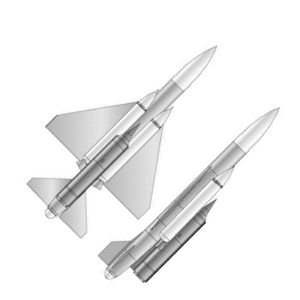
Home - Search - Browse - Alphabetic Index: 0- 1- 2- 3- 4- 5- 6- 7- 8- 9
A- B- C- D- E- F- G- H- I- J- K- L- M- N- O- P- Q- R- S- T- U- V- W- X- Y- Z
R-500
 P-500 Credit: © Mark Wade |
AKA: KR-500;S-500. Status: Cancelled 1961. Apogee: 35 km (21 mi).
Mikoyan's OKB-155 was assigned the task in June 1958 of developing an experimental unpiloted fighter R-500 (KR-500), which was to destroy high-altitude, high-speed aircraft and winged cruise missiles (e.g. the North American B-70 bomber and Navaho cruise missile). This equivalent of the American Bomarc was to have a range of 80 to 1000 km, be capable of cruising toward its targets at 25 to 30 km altitude, and have a speed of 4700 kph. It was cancelled in 1960.
The rocket was launched and controlled by the S-500 system, which would have been deployed at fixed sites near radar stations. The cruise stage had a conventional aircraft layout, with an all-moving tail, and no elevons. It was planned that later versions of the missile would use gas-dynamic steering to allow control at altitudes of up to 35 km, where aerodynamic controls would be ineffective. The missile was to be launched vertically, and have an active self-guiding capability. The RD-085 ramjet engine by Bondaryuk reached the pre-draft project stage in November 1960. Two solid boosters would have taken the cruise stage to Mach 2 at 4 km altitude, where the ramjet would ignite.
Various engine combinations were studied to prevent flameout of the ramjet at high angles of attack during ascent and maneuvering. Internally, the missile was equipped with an autopilot, electrical turbogenerator, warhead integrated with the acting homing guidance system, command link to the ground, and a proximity fuse with a self-destruct system. The missile would be guided to the target by ground command, with the assistance of the inertial navigation system. In the first phase of intercept the missile would fly at 15 to 18 km altitude and Mach 3.5. It would then accelerate to Mach 4.3 and pull up to intercept targets at 25 km altitude. Total flight time would be 20 minutes, and the intercept would be conducted in classic fighter fashion, the missile turning at the correct point to approach the target from the rear. The Americans cancelled the Navaho, and the future of the B-58 and B-70 projects looked shaky, so the S-500 was cancelled in 1961 due to lack of potential targets...
Maximum range: 1,000 km (600 mi). Boost Propulsion: Solid rocket. Maximum speed: 4,700 kph (2,900 mph). Minimum range: 80 km (49 mi).
Family: surface-to-air. Country: Russia. Agency: MiG. Bibliography: 571.
Back to top of page
Home - Search - Browse - Alphabetic Index: 0- 1- 2- 3- 4- 5- 6- 7- 8- 9
A- B- C- D- E- F- G- H- I- J- K- L- M- N- O- P- Q- R- S- T- U- V- W- X- Y- Z
© 1997-2019 Mark Wade - Contact
© / Conditions for Use